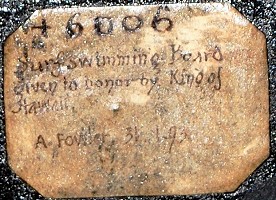surfresearch.com.au
 |
surfresearch.com.au
the catalogue #537
|
| c1850 Alaia 5ft 11'' |
#537 |

MANUFACTURE
MANUFACTURER: Traditional
SHAPER: Unknown
DESIGN: Alaia
DESIGNER: Traditional
SPECIFICATIONS
CONSTRUCTION
"Light coloured wood
painted black."
One piece solid timber, painted or stained.
DIMENSIONS
|
Length :
|
5 |
ft |
11 |
inches |
L2: |
|
|
Width :
|
13
|
inches |
|
Wide Point :
|
|
inches |
|
Nose :
|
|
inches |
|
Tail :
|
|
inches |
|
Thickness :
|
2 |
inches |
|
Pod :
|
11
|
inches |
|
Nose Lift :
|
|
inches |
|
Tail Lift :
|
|
inches |
|
Weight :
|
|
kilos |
|
Volume :
|
|
litres |
|
Other :
|
|
pounds |
|
|
|
|
FEATURES
Nose:
round
Tail:
rounded square
Deck:
flat (concave-convex)
Bottom:
flat (concave-convex)
Rails:
[rounded square]
Rocker:
Note: There are
five holes on the right
hand rail, probably used to secure the board in
some type of display, before it was removed and
passed on to Alfred Fowler
in 1890, image right.
|
|
FIN
None, standard for the period.
DECOR
DECAL:
MARKINGS:
The catalogue number, +6006, in
white paint and a metal catalogue plate is affixed on the
bottom at the nose:
+6006
Surf
swimming board given in honour by King of Hawaii.
A.
Fowler 31.1.1893.
COLOUR
: stained - painted
|
|
BRITISH MUSEUM ONLINE CATALOGUE DESCRIPTION
Object type: surf-board
Museum number: Oc,+.6006
Description
Surf board, a long black wooden board with a rounded leading
edge, tapering slightly along length to a straight-edged end.
Nearly consistent depth across board.
Regular, rectangular holes cut in along the two long sides,
ranging from 0.5 to 1cm from the edge.
One hole rounded, as if to fit a screw.
Findspot: Found/Aquired: Hawaii
Materials: wood
Dimensions
Length: 181 centimetres
Width: 33 centimetres
Depth: 0.5 centimetres
Christy collection registration slip description, written in
1893?:
Hawaiian Group
Surf swimming board, consisting of a plank 5’ 11” long the edges
nearly parallel, the width ranging from nearly 11” to 13” one
end square the other rounded.
The faces are concavo-convex.(sic)
Light coloured wood painted black.
Given to the Donor by King
Condition
Has cracks and splits.
Especially vulnerable along long sides where the holes have
weakened the edge, some splitting and breaking of the wood next
to holes.
Conservation
Treatment date: 21 December 2004
Reason for treatment: Loan
Treatment proposal: Clean
Condition: Light surface dirt
Treatment details: Cleaned with Wishab sponge
(vulcanized latex,filler).
Removed remains of Wishab with soft brush and vacuum cleaner
Subjects: sport/pastime
Acquisition name: Donated by: Alfred
Fowler
Acquisition date: 1893
Department: Africa, Oceania & the
Americas
Registration number: Oc,+.6006
Additional IDs:
Oc1893C2.6006 (old CDMS no.)
COMMENTS ON THE BRITISH MUSEUM
CATALOGUE DESCRIPTION
The catalogue gives two descriptions, the first a
recent one (in metric), and reproduces an earlier description
circa 1893, in imperial dimensions.
Only the early description notes the wood is painted and the concavo-convex (sic)
faces.
The later
description notes the "regular, rectangular holes cut in
along the two long sides, ranging from 0.5 to 1cm from the
edge" and
one "rounded,
as if to fit a screw."
These are five holes
on the right hand rail, probably
used to secure the board with rope, hooks, or screws, in
some type of wall display, before it was removed and
passed on to Alfred Fowler in 1890.
Contrary to common practice, the photographs of the board
are shot from the nose, with the template seriously
compromised by the perspective.
An attempt has been made to adjust this in the image at
the top of this entry.
The conservation
treatment, essentially a delicate clean, in December 2004 was possibly in preparation
for loan to the Museum of British Surfing, but I can
find no record of such an exhibition.
BOARD HISTORY
This surfboard, +6006, was donated to the
British Museum, London, in 1893 by Alfred Fowler, who was personally
presented with the board by the King of the Sandwich Isles, Kalakaua.
Alfred Fowler,
of Leeds, arrived in Honolulu in March 1890
as a representative
of John Fowler & Co, the family engineering and steam locomotive business, and was instantly embraced by
the Royal court and the cream of local society.
While in the islands he travelled extensively, often in the
company of Col .Macfarlane, effectively the English
ambassdor to the Hawaiian court, and, occasionally, with the
King himself.
Flower also had time to court Miss Eva Neumann, the
daughter of a prominant Honolulu family; their engaement
announced on 1st July and the ceremony, "one of the
most brilliant weddings that has taken place in Honolulu," was
conducted at St Andrews Cathedral on 19th November.
The couple were later honoured
with a royal breakfast at the Iolani Palace where "their
Majesties presented Mrs Fowler with a handsome mamo lei (a rare royal feather necklace) enclosed in a carved sandal wood case as a wedding
present."
Before
departing for England in late December 1890, Albert Fowler was
also presented with a "surf
swimming board," undoubtedly, like the mamo lei,
from the royal collection.
On his return to England, Fowler donated a number of Polynesian artifacts to the
British Museum collection, including the surfboard on 31st January 1893, where it
was given the catalogue number +6006.
King Kalakaua
was known to be an enthusiastic supporter of tradtional
Hawai'ian culture, particularly demonstrated at his Waikiki
luaus, that often featured exhibitions of surfboard
riding, in the late 1880s.
One account by an English guest in 1887 reported that the
King "personally
took us to his seaside (residence) and there gave us its
freedom and from its windows pointed out to us the
native skill at surfriding."
An American military
officer wrote a similar account and provided
illustrations of surfboards of similar dimensions to
+6006.
The board given to Fowler,
however, was surely a board of considerable antiquity.
Certainly its
poor condition upon acquisition suggests it was unlikely to be
in regular use, and the five holes on the right hand
rail indicate that it had probably been previously
mounted as a display.
Tthe
inital BM cataloguer described
the board as "light coloured wood,"
possibly suggesting the timber is not
koa, and "painted
black,"
which may be a traditional preservative.
Measuring 5ft 11 in x 13in, the board
was probably ridden prone, however, it is at the
extreme minimum for riding kneeling or standing.
It is unclear if the British
Museum ever exhibited the board, however, it
must be noted that its template and
dimensions approximate the prone boards used
on the beaches of England, and
her colonies (hence, Empire boards), in the early
20th century
In December 2004, the board was cleaned in preparation for
loan, possibly for the Museum of British Surfing,
but I can find no record of such an exhibition.
The board has recently been added to the
British Museum's online catalogue.
http://www.britishmuseum.org/research/collection_online/search.aspx
Seach terms:
Note that, contrary to common practice, the
photographs of the board are shot from the
nose, and the curvature of the template is
significantly exaggerated by the
perspective.
King Kalakaua's
Surfriding Luaus, 1887.
"Personally he took us to his seaside
(residence) and there gave us its freedom and from its
windows pointed out to us the native skill at surfriding."
-
Bath Independent,
England, August 27, 1887, page 1.
The illustrations below accompanyied a similar account by American military officer, with
boards of
similar dimensions to #6006.
-The Sun, New
York, August 28, 1887, page 9.
At these dimensions,
5ft 11 in x 13in, this board is at the absolute minimum
required to ride kneeling, if not standing.
In 1890, the board was illustrated by James
Edge-Partington in his An Album of the Weapons, Tools,
Ornaments, Articles of Dress of the Natives of the Pacific
Islands, J.
Edge-Partington & Charles Heape, Manchester, 1890.
Lithographed by J.C. Norbury, the album comprised drawings from examples in public
& private collections in England.
In 1899, the illustration was reproduced by Stewart Culin in an
article, Hawaiian
Games, in the American Anthropologist, Volume
1, Number 2, New York, April 1899, page 213.

FIG.
4-Surf-board of hard, blackened wood; length 71 inches.
British Museum.
(From Ethnographic
Album
of the Pacific Islands, II, 33 No. 1.) - Adjusted
position.
Alfred Fowler in Hawaii, 1890
PERSONAL
Mr. Alfred Fowler, of London, will visit the now
Kauai sugar estate this week, sailing on the Mikulinhi this
afternoon, in company with Col.
G.W. Macfarlane.
Mr. Fowler was presented to His Majesty at the Palace last week,
and paid his respects to the British Commissioner, besides calling
on the leading merchants here, with whom his firm have had large
transactions in tiie past few years.
The firm's make of railways and steam ploughs arc known all over
the Islands.
Mr. Fowler will leave for the Volcano next week, and also visit
the Palinhi estate at Kau, in which his firm is interested.
He will leave the latter part of next month, for Japan and China,
on his journey round the world.
- The Daily bulletin. (Honolulu [Hawaii]) 1882-1895,
March 18, 1890, Image 3
Image and text provided by University of Hawaii at Manoa;
Honolulu, HI
Persistent link: http://chroniclingamerica.loc.gov/lccn/sn82016412/1890-03-18/ed-1/seq-3/
Mr. Alfred Fowler of the firm of John Fowler & Co., England,
arrived on the Australia, and is the guest of Col. G. W.
Macfarlane, H. M.'s Chamberlain.
- The Hawaiian gazette. (Honolulu [Oahu, Hawaii])
1865-1918, March 18, 1890, Image 7
Image and text provided by University of Hawaii at Manoa;
Honolulu, HI
Persistent link: http://chroniclingamerica.loc.gov/lccn/sn83025121/1890-03-18/ed-1/seq-7/
PERSONAL NOTES.
His Majesty arrived at Kailna early Saturday
morning week on the steamer V. Gr. Hall.
Mr. Alfred Fowler, Col. (J. "VT. Macfarlane and Mr. Allan Herbert
also landed there.
The Gilling party, who were on the same steamer, on their way to
the Volcano, were invited by His Majesty to remain two days at
Kailna.
H. B. M. S. Champion arrived at Kailaa. Sunday morning,
and carried the Gillig party and they went from there to the
Volcano House.
The King embarked on the Champion at Kailna on Tuesday
and was taken around to Hilo, where he remained until Monday, when
the Champion will bring him to Honolulu, arriving Tuesday
morning.
Capt. St. Clair, after mooring his vessel safely at Hilo, was to
proceed to the Volcano.
Mr. Alfred Fowler accompanied the Gillig party to the Volcano, he
having with Col. Macfarlane made an inspection of the districts of
Kailna and Kona.
Mr. Herbert and Col .Macfarlane, the latter who had private land
matters to attend to for His Majesty remained over to make a
further inspection of the districts, and returned nday on the V.
Or. Hall.
- The Hawaiian gazette. (Honolulu [Oahu,
Hawaii]) 1865-1918, April 29, 1890, Image 1
Image and text provided by University of Hawaii at Manoa;
Honolulu, HI
Persistent link: http://chroniclingamerica.loc.gov/lccn/sn83025121/1890-04-29/ed-1/seq-1/
ROYAL MUSICALE.
Their Majesties the King and
Queen Give the First of a Series or Entertainments at the Palace
A. Fine Programme.
Tuesday evening Their Majesties the King and
Queen gave the first of a series of musicales at Iolani Palace.
It was held in the blue room which was most tastily decorated with
potted ferns and palms, and flowers.
...
Their Majesties were most affable to all.
One interesting feature was the display of the feather cloaks in
the Throne room.
The whole interior of the Palace was brilliantly illuminated with
the electric light.
...
Those present were: Their Majesties the King and Queen, H. R. H.
Princess Liliuokalani,
...
Messrs. ..., Alfred Fowler,
- The Hawaiian gazette. (Honolulu [Oahu, Hawaii])
1865-1918, May 13, 1890, Image 5
Image and text provided by University of Hawaii at Manoa;
Honolulu, HI
Persistent link: http://chroniclingamerica.loc.gov/lccn/sn83025121/1890-05-13/ed-1/seq-5/
By the ship Borrowdale, which arrived this morning, three of
Messrs. John Fowler & Co.'s steam ploughs, were received by O.
W. Macfalane & Co.
One for H. P. Baldwin's estate, one for Col. Spalding, and one for
R. Halslead.
Besides these ploughs a huge lot of rails came to hand, as well as
sugar machinery from Messrs. Mirrlees, Watson & Co.
Mr. Alfred Fowler arrived by the Likelike from Maui
yesterday.
- The Daily bulletin. (Honolulu [Hawaii]) 1882-1895, May
19, 1890, Image 3
Image and text provided by University of Hawaii at Manoa;
Honolulu, HI
Persistent link: http://chroniclingamerica.loc.gov/lccn/sn82016412/1890-05-19/ed-1/seq-3/
BREAKFAST AT IOLANI PALACE.
His Majesty the King enteitained at breakfast
yesterday morning at the palace, Mr. Alfred Fowler, of London,
prior to his departure for Japan.
The following gentlemen were invited to meet Mr. Fowler, vi. :
Hon. John O. Domini-,, Hon. A. S. Clegiiorn, Capl. A. St. Clair,
U. N., Mr. F. A. Sclinefer, Mr. J. II. J'aty, lions. I Neumann, G.
Irwin, H. I. Hahlwin, W. H. Cornwell, Sand, l'arker, Mr. F.
Spencer, and Mr. Herbert.
The Chamberlain, Col. G. W. Macfarlane, and Mr. J. W. Robertson,
Vice-Chamberlain, were present at the breakfast.
- The Daily bulletin. (Honolulu [Hawaii]) 1882-1895, May
27, 1890, Image 2
Image and text provided by University of Hawaii at Manoa;
Honolulu, HI
Persistent link: http://chroniclingamerica.loc.gov/lccn/sn82016412/1890-05-27/ed-1/seq-2/
Farewell Dinner.
Last Saturday evening the Hons. Sam. Parker and
W. H. Cornwell gave a dinner at the Hawaiian Hotel in honor of Mr.
Alfred Fowler of England who leaves to-day for Japan.
Those who sat down at table were: His Majesty the King, Mr. Alfred
Fowler, Capt. St. Claire of H. B. M. S. Champion, Hons. Paul
Neumann, John O. Dominis, EC. Macfarlane, Wm. G-. Irwin, S.Parker
and W. H. Cornwell, Col. G. W. Macfarlane and Mr. Allen Herbert.
The Hawaiian string band occupied a position on the versed near
the dining room and gave voeal and instrumental selections during
the dinner, which was a very pleasant affair.
- The Hawaiian gazette. (Honolulu [Oahu, Hawaii])
1865-1918, May 27, 1890, Image 7
Image and text provided by University of Hawaii at Manoa;
Honolulu, HI
Persistent link: http://chroniclingamerica.loc.gov/lccn/sn83025121/1890-05-27/ed-1/seq-7/
Mr. Alfred Fowler accompanies Mr. R. A. Macfie, Jr.,
this evening, to Kauai, to visit the Macfie Sugar Estate at
Kilauea, and see the great results of steam ploughing on this
plantation.
It is said the output of this estate this year will reach 3500
tons, while a few years ago, the average crops were about 1000
tons.
The Daily bulletin. (Honolulu [Hawaii]) 1882-1895, June 03,
1890, Image 3
Image and text provided by University of Hawaii at Manoa;
Honolulu, HI
Persistent link: http://chroniclingamerica.loc.gov/lccn/sn82016412/1890-06-03/ed-1/seq-3/
Mr. Alfred Fowler decided last week not so leave on the
Yamashiro Maru, as two steamers leave next month for
Yokohama and he was desirous of visiting Hilo and Hamakua.
- The Hawaiian gazette. (Honolulu [Oahu, Hawaii])
1865-1918, June 03, 1890, Image 7
Image and text provided by University of Hawaii at Manoa;
Honolulu, HI
Persistent link: http://chroniclingamerica.loc.gov/lccn/sn83025121/1890-06-03/ed-1/seq-7/
A GRAND BALL
King Kalakaua Entertains Regally at Iolani Palace.
Among those present were: .. Albert Fowler ... Hon. Paul Neumann, Miss Eva Neumann
- The Hawaiian gazette. (Honolulu
[Oahu, Hawaii]) 1865-1918, June 10, 1890, Image 6
Image and text provided by University of Hawaii at Manoa;
Honolulu, HI
Persistent link: http://chroniclingamerica.loc.gov/lccn/sn83025121/1890-06-10/ed-1/seq-6/
LOCAL AND GENERAL.
The engagement has been announced of Miss Eva
Neumann, eldest daughter of Hon. Paul to Mr. Alfred Fowler of
London, junior member of the firm of John Fowler & Co., of
Leeds and London.
- The Hawaiian gazette. (Honolulu [Oahu, Hawaii])
1865-1918, July 01, 1890, Image 7
Image and text provided by University of Hawaii at Manoa;
Honolulu, HI
Persistent link: http://chroniclingamerica.loc.gov/lccn/sn83025121/1890-07-01/ed-1/seq-7/
MARRIED
...
FOWLER-NEUMANN
At St Andrews Cathedral, Honolulu, Nov 19 by the Rev Alex
Mackintosh.
Alfred Fowler Esq of London England to Eva, eldest daughter of Hon
Paul and Mrs Neumann.
- The Hawaiian gazette. (Honolulu [Oahu, Hawaii])
1865-1918, November 25, 1890, Image 11
Image and text provided by University of Hawaii at Manoa;
Honolulu, HI
Persistent link:
http://chroniclingamerica.loc.gov/lccn/sn83025121/1890-11-25/ed-1/seq-11/
A BRILLIANT WEDDING
Mr Alfred Fowler and Miss Neumann Married
ST ANDREWS CATHEDRAL WHERE
THE CEREMONY WAS CROWDED TO THE DOORS
The Fashionable Assembledge - The Reception,
Presents, Music Etc
One of the most brilliant weddings that has taken place in
Honolulu was that at St Andrews Cathedral Wednesday evening when
Mr Alfred Fowler and Miss Eva Neumann were united in the holy
bonds of matrimony.
Miss Eva Neumann is the eldest daughter of the Hon Paul and Mrs
Neumann and has been a bright ornament in Honolulu society circles
from which she will be much missed.
Handsome, highly accomplished, having travelled extensively and
charmingly gracious in manner she has endeared herself to hundreds
of friends.
Mr Fowler, the bridegroom, is the junior member of the well known
firm of Messrs John Fowler Co of Leeds and London, England, and a
gentleman of cultured taste one who makes friends wherever he
goes.
He is a most excellent business man.
The invitations announced the ceremony for 8:15 oclock but long
before that hour the cathedral was crowded in every part and many
hundreds of persons were simply unable to obtain admission.
Even the windows were filled with people anxious to get a glimpse
of the bridal party.
There was no attempt at decorations, only two handsome bouquets of
choice white flowers which stood on the altar.
The ushers were Mr Oscar Herold, Mr J M Monsarrat, Ensign Blow and
Cadet Gartley of the flagship Charleston.
These gentlemen were kept quite busy showing the invited guests to
their seats
At 8:05 the organ struck up with a Wedding Hymn by Randegger,
followed by a Wedding March by Warneford, Mr Wray Taylor presiding
at the instrument.
During this time the groomsmen took their places at the head of
the nave.
At 8.20 o'clock the arrival of the bride was announced by the
strains of the Lohengrin Bridal March.
Leaning on the arm of her father the bride advanced slowly up the
aisle to the chancel steps where she was met by the bridegroom.
Mr T McKenzie Fowler, a cousin of the bridegroom, was best man
having accompanied Mr Fowler from the Colonies for that purpose
Col the Hon Gr V Macfarlane, H,Ms Chamberlain and a close friend
of Mr Fowlers, was a groomsman, the others being Assistant
Engineer
Jones and Cadet Churchill of the Flagship Charleston, Messrs John
S Walker Jr, Ernest H Wodehouse and Alika C Dowsett.
The maid of honor was Miss Inez Neumann, sister of the bride, who
looked very pretty in a costume of pale green trimmed with pink
and lace.
The bridesmaids were Miss Agnes Walker dressed in pale blue, Miss
Rena Herbert in white, Miss McGrew in acrne, Miss Hattie Brown in
rose, Miss Helen Wilder in lavender, and Miss Delia Widdifield in
canary color.
Mrs Neumann, mother of the bride, occupied a seat in the royal pew
during the ceremony.
The bride looked perfectly lovely in a handsome costume of ivory
colored satin en train, trimmed with orange blossoms and wearing a
white tulle veil.
After the bridal party had taken their position at the chancel
steps, our popular clergyman the Rev Alexander Mackintosh,
commenced
the ceremony performing it in such a manner as to deeply impress
the vast assemblage an undercurrent of melody issuing from the
organ throughout.
The bride was given away by her father.
After the ceremony, the bridal party withdrew to the vestry to
sign the register while the choir of ladies and gentlemen sang the
hymn, "The Voice That Breathed O'er Eden."
As they left the cathedral Mendelssohns Wedding March pealed forth
from the organ
Between the hours of 9 and 11 o'clock, a reception was held at the
residence of the brides parents, King street.
The parlors were decorated with flowers flags and evergreens.
A canopy of white tulle wreathed with choice flowers occupied one
corner of the main parlor and suspended from it was an exceedingly
handsome marriage bell of white chrysanthemums and yellow roses.
Under this, the happy couple received congratulations which were
eagerly offered by their large circle of friends and other
specially invited guests.
Panels of different colored flowers principally roses are to be
seen in every direction lie the veranda, with its wns of nags and
illuminated by any colored lanterns presented a very pretty scene.
In one of the rooms on the wall were the initials in white and
green E N and A F
The grounds were also illuminated with lanterns and torches.
The Royal Hawaiian Band was present, and under the skillful
direction of Bandmaster Berger, played a choice programme of music
The presents were very numerous and of the most costly nature.
The wedding cake made by warm friends of the brides family was a
very handsome one.
Refreshments were served during the evening in abundance.
After the reception dancing was indulged in to a late hour.
Mr and Mrs Fowler will leave on the K M S Mariposa December 20th
for the Colonies, thence to England by way of India.
The Advertiser extends its congratulations and wishes them a
joyful wedded life.
- The Hawaiian gazette. (Honolulu [Oahu, Hawaii])
1865-1918, November 25, 1890, Image 10
Image and text provided by University of Hawaii at Manoa;
Honolulu, HI
Persistent link:
http://chroniclingamerica.loc.gov/lccn/sn83025121/1890-11-25/ed-1/seq-10/
Royal Breakfast and
Presentation
A breakfast was given at Iolani Palace Sunday
morning in honor of Mr and Mrs Alfred Fowler
Those present were Their Majesties the King and Queen, Hon Paul
and Mrs Neumann, Mr and Mrs Alfred Fowler, Miss Inez Neumann, Miss
Finckler, Hon G W Macfarlane, H M s Chamberlain, Mr T McKenzie
Fowler, Mr J W Robertson, H Ms Vice Chamberlain, and Mrs
Robertson.
After the breakfast, their Majesties presented Mrs Fowler with a
handsome mamo lei enclosed in a carved sandal wood case as a
wedding present.
This gift of a rare royal feather necklace is the greatest
compliment that can be bestowed.
- The Hawaiian gazette. (Honolulu [Oahu, Hawaii])
1865-1918, November 25, 1890, Image 7
Image and text provided by University of Hawaii at Manoa;
Honolulu, HI
Persistent link:
http://chroniclingamerica.loc.gov/lccn/sn83025121/1890-11-25/ed-1/seq-7/
PLEASANT PALACE PARTY.
Impromptu Ball In Honor of
the King, Admiral Brown, and Mr. and Mrs. Fowler.
On such short consideration that it may fairly be
called impromptu, a committee of ladies gave a ball at Iolani
Palace last night, by consent
and under the patronage of Their Majesties.
The event was designed as a pleasant send-off to the King, Admiral
Brown and officers of the Charleston, and Mr. and Mrs. Fowler.
- The Daily bulletin. (Honolulu [Hawaii]) 1882-1895,
November 25, 1890, Image 3
Image and text provided by University of Hawaii at Manoa;
Honolulu, HI
Persistent link: http://chroniclingamerica.loc.gov/lccn/sn82016412/1890-11-25/ed-1/seq-3/
DANCE AT THE PALACE
A Large Gathering of Society People and Officers of the War
Ships
The dance at Iolani Palace Monday evening given
by the ladies as a farewell to His Majesty Admiral Brown, Capt
Bemey and officers of
the TJ S Flagship Charleston and Mr and Mrs Alfred Fowler was
quite a brilliant affair.
The blue room and the grand hallway were very prettily decorated
with a profusion of tropical flowers and evergreens.
The brilliancy of the electric light which illuminated the
interior of the building added much to the effectiveness of the
scene.
Their Majesties the King and Queen and H B H Princess Poomaikelani
stood at the entrance to the throne room while those who were
present paid their respects.
This informal reception being over dancing at once commenced to
the strains of the Hawaiian string orchestra stationed on the
front veranda.
Among those presentwere Admiral Brown the captains and officers of
the men-of-war in port members of the diplomatic and consular corp
and a large number of prominent society people.
The programme contained twelve dances.
Shortly before midnight supper was served in the dining hall.
At intervals during the evening the Quintette club sang
selections on the back veranda of the Palace.
The whole affair was exceedingly pleasant.
- The Hawaiian gazette. (Honolulu [Oahu, Hawaii])
1865-1918, December 02, 1890, Image 3
Image and text provided by University of Hawaii at Manoa;
Honolulu, HI
Persistent link:
http://chroniclingamerica.loc.gov/lccn/sn83025121/1890-12-02/ed-1/seq-3/
MARRIAGES.
Among the couples
joining "for better, for worse" during the year were the
following:
...
Mr. Alfred Fowler and Miss Eva Neumann.
- The Daily bulletin. (Honolulu [Hawaii]) 1882-1895,
December 31, 1890, Image 5
Image and text provided by University of Hawaii at Manoa;
Honolulu, HI
Persistent link: http://chroniclingamerica.loc.gov/lccn/sn82016412/1890-12-31/ed-1/seq-5/
DESIGN HISTORY
The Polynesians arrived in Hawaii circa
1000 B.C. with an unequalled maritime knowledge and skills to the
finest surfing location on the planet.
Not only was there consistant swell and
a tropical climate, but a previously untapped store of timber.
Unihabited for X0000 million years, the Hawiian Islands had
produced a massive store of surfboard building materials - trees
large enough to build sixty foot canoes
The main timbers were...
Willi Willi (Erythrina sandwicenis) -
a light timber similar to balsa wood and used for outrigger
floats.
Breadfruit or Ulu (Artocarpus altila)
- also light
Koa.(Accacia koa) -a fine grained
hardwood.
Some reports suggest that Breadfruit
or Wilii Willi were preferred timbers (particually for the
longer Olo) for their lightness (and ease of shaping?), however
the only existing examples of these boards are in Koa
wood. Probably the lightweight nature of these timbers was
the cause of their disappearance.
Some small (Paipo) examples exist in
Breadfruit.
A tree was selected and felled,
sometimes with religous ceremony or offerings, and a board was
roughly shaped by a stone adze on site.
The board was then moved to a
canoehouse or beach site where the shape was completed
progressively with adze, various coral heads and an oahi
rubbing stone.
Several staining agents were
availaible...
Root of theTi plant (Mole ki)
Juice of pounded Kukui bark
Soot of burnt kukui nuts
Charcoal from burnt pandanus leaves
Juice from banana buds
Ashes of burnt cane leaves
Usually several agents were mixed to
produce a glossy black finish.
One account quoted by Tom Blake in Hawaiian
Surfboard (1935, page 45)
states that a willi willi board
was immersed in mud to seal the timber grain.
The finishing process was completed
with the addition of kukui nut or coconut oil to assist
waterproofing.
These contruction processes were not exclusive to surfboards -
they were standard practice in canoe building.
Further coatings of oil were
regularly applied as ongoing maintainence.
After use boards were dried and
stored, sometimes wrapped in cloth.
Dimensions vary between 6 feet and 12
feet in length, average 18 inches in width, and between half
an inch and an inch and a half thick.
The nose is round and turned up, the
tail square.
The deck and the bottom are
convex, tapering to thin rounded rails.
This cross-section would maintain
maximum strength along the centre of the board and the rounded
bottom gave directional stability, a crucial factor as the boards
did not have fins.
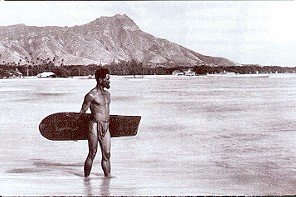 |
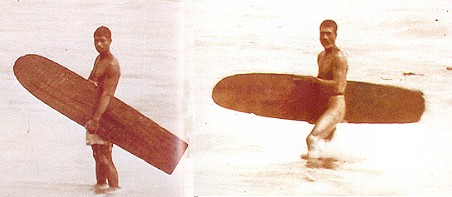 |
Alaia and Surfer,
Waikiki 1890
(Bishop Museum)
Kampion,
Page 29
|
Surfers and
Alaia, Hilo Bay, Hawai'i circa 1900
(Bishop Museum)
Cropped from Lueras,
page 56 and 57
|
Any
discussion of the performance capabilities is largely
speculation.
Contemporary accounts definitely
confirm that Alaia were ridden prone, kneeling and standing; and
that the riders cut diagonally across the wave.
Details of wave size, wave shape,
stance and/or manouvres are, as would be expected, overlooked by
most non-surfing observers.
Most early illustrations of surfing
simply fail to represent any understanding of the mechanics of
wave riding. Modern surfing experience would suggest that high
performance surfing is limited more by skill than equipment.
It is a distinct probablity that
ancient surfers rode large hollow waves deep in the curl -
certainly prone, and on occassions standing.
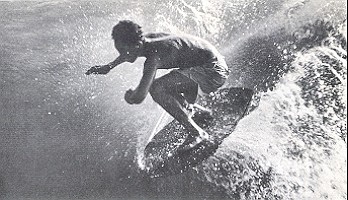
|
Standing Rider on
Paipo/Belly board,
Kuhio
Pier, Waikiki, circa 1962.
Photograph by Val Valentine
Kelly,
facing page 192.
|
By 1000 A.D
these principles were confirmed...
13. Large waves are faster than small
waves.- a larger board is easier to achieve take off.
14. Steep waves are faster than flat
waves.- a smaller board is easier to control at take off.
15. Control is more important than
speed
16. Surfboards are precious.
Plans
and Specifications : Alaia, 1938

Above: #6006 to scape, template adjusted.
Right: Perspective shots of deck and bottom. |
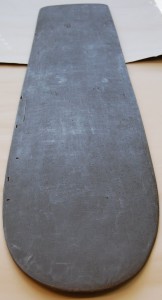 |
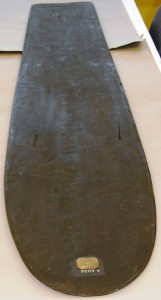 |


surfresearch.com.au
Geoff
Cater (2004 - 2014) : #537 Alaia, 5ft 11'', c1850.
http://www.surfresearch.com.au/00000537.html




